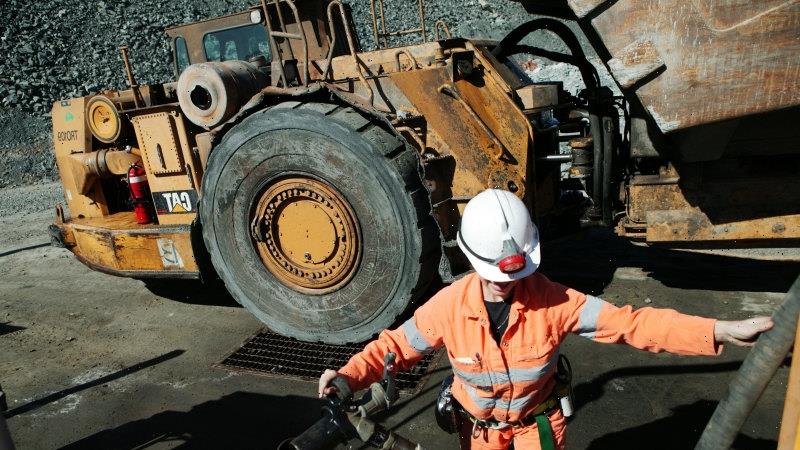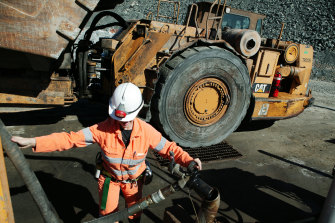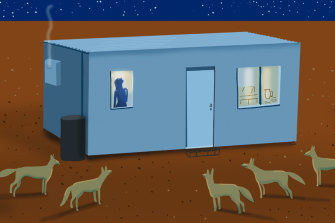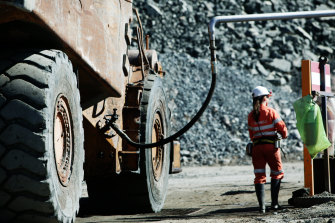Pity the poor, cliched canary. Its delicate sensibilities and sweet song saw it carted down into filthy coal mines for decades in Britain and Australia to provide early warning signs that dangerous toxic gases were gathering: the sight of a pile of yellow feathers on a carrier floor a clear indication humans should exit.
Women have stomped on the idea that they can’t work in mines.Credit:
Curious, then, that the year they were officially phased out was the year women were finally allowed to work in underground mines in West Australia. It was 1986, when Bob Hawke was prime minister, the Azaria Chamberlain case was grinding on, a nuclear reactor exploded in Chernobyl, and Crocodile Dundee was released.
And women finally stomped on the idea that they were too weak to do subterranean mining work.
The birds came up and the women went down.
And what the women have been exposed to – below the ground and above in the mining industry – has been toxic, too.
A deeply disturbing inquiry into sexual assault and harassment in the fly-in, fly-out mining industry in WA has revealed hundreds of complaints of rape, groping and harassment, along with evidence of cultures that buried reports, treated assaults as an HR issue and punished complainants, leaving victims afraid to speak up.
The culture is clearly baked in: one where late night banging on the doors of women’s portable bedrooms in camps was called “doorknock appeals”, where women were abused with terms like “silly little bitch” and “site screws”, had porn uploaded on computer screens, of drugs slid into drinks, intimidation, grooming and date rape. A superintendent asked a truck driver if she’d like to have sex with him in order to make a safety report “go away”. A supervisor, after driving to a remote lookout then unzipping his pants to reveal a lack of underwear, bluntly said: “If you want your [company] shirt, you have to get on your knees first.”
Illustration: Simon LetchCredit:
On one project, after two men were sacked for sexual harassment, the complainants were reminded that they had done a “huge thing” to the careers of the men involved, that colleagues had complained about them “dressing very provocatively”, that they should avoid close-fitting jeans or short shorts as men thought they were “asking for it”.
According to a submission by the Western Mine Workers’ Alliance, a survey of 425 workers in WA’s mining sector found nearly a quarter of all women had experienced sexual assault at work. One in three had been asked for a sexual favour while two in three had been verbally harassed.
It must be remembered these figures are notoriously underreported.
The incidence of sexual harassment in the mining industry was significantly higher than other workforces.Credit:Fairfax
In her landmark Respect@Work report, Sex Discrimination Commissioner Kate Jenkins found that the incidence of sexual harassment in the mining industry – at 40 per cent – was significantly higher than other workforces, which averaged 31 per cent.
Little wonder mining is close to the worst performing sector in the country when it comes to gender diversity – the workplace Gender Equality Agency’s 2020 financial year report found women comprise only 18 per cent of the workforce, and only 7.6 per cent of chief executives.
So here is the rub – surely women need to be in positions of leadership if equality is to be ushered in more broadly and toxic, even criminal behaviours, ushered out? These largely male-led companies have been dragged to the court of public accountability only after dogged media reporting and courageous story telling. They have ignored and minimised the problem for decades.
Now, wilting under the glare of public scrutiny, the major mining companies have publicly apologised, vowed to do better and taken care of some low-hanging fruit like putting locks on doors and installing security cameras. Mid-year, a group of mining companies – BHP, Rio Tinto, Fortescue Metals Group, Woodside and Newmont – held a press conference to apologise to women who had been harassed or assaulted and declare a zero tolerance policy.
But what’s really needed is deep, difficult, cultural change. Surely, the answer is not just to lock women’s doors but change a culture where you even need to lock doors.
Rio Tinto told the inquiry that in the past five years it had 93 claims of harassment, with 69 cases of workers disciplined for sexual misconduct, and 34 fired. At BHP, in the past two years, there were 73 reports; 48 resulted in an end to employment.
But it has also become apparent that many reports are ignored, get “lost” in the system or have little consequence: only one in 12 sexual misconduct and bullying complaints at WA mining companies in the past five years had resulted in the industry regulator issuing an improvement notice. Out of the 13, only eight have been officially complied with.
And they wonder why women don’t report?
The environment has changed though; The West Australian’s Caitlyn Rintoul’s dogged reporting prompted the inquiry, which, while not reporting until April, has been genuinely alarming for many.
Indigenous women have been dealing with a particularly brutal intersection of sexual harassment with racism on these sites – theirs are the stories we need to hear more of. And they’re losing patience. Nicole Brown from the Indigenous Women in Mining and Resources told me on The Drum: “We aim to get out there and empower and inspire our women. We deserve to be there. So for them to go through what they’re going through on site is just unfathomable. But in order to create change we need to speak up and make sure this dialogue is out there in the front of everybody. We need to be heard … there is so much bullying, violence, the stuff that’s happening on mine sites.”
The mining industry has long known it has serious problems with not just attracting but also retaining women.
A McKinsey Report from September identified a precipitous global drop off from entry to executive for women in mining companies. Female representation within their C-suites is 13 per cent, making the industry “a laggard among laggards”.
The resources sector, long the ballast of our economy, is already facing intense pressure to rapidly adapt to a future of sustainability and decarbonisation. Doing this without significant female leadership or genuine change to a culture where women are more likely to be pawed than promoted will only hasten its demise.
The Morning Edition newsletter is our guide to the day’s most important and interesting stories, analysis and insights. Sign up here.
Most Viewed in National
From our partners
Source: Read Full Article



